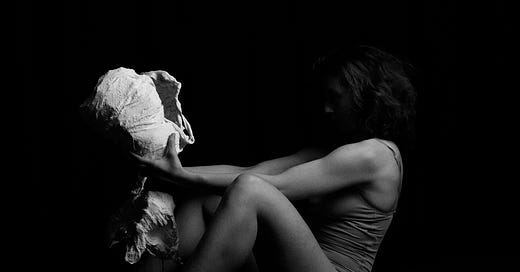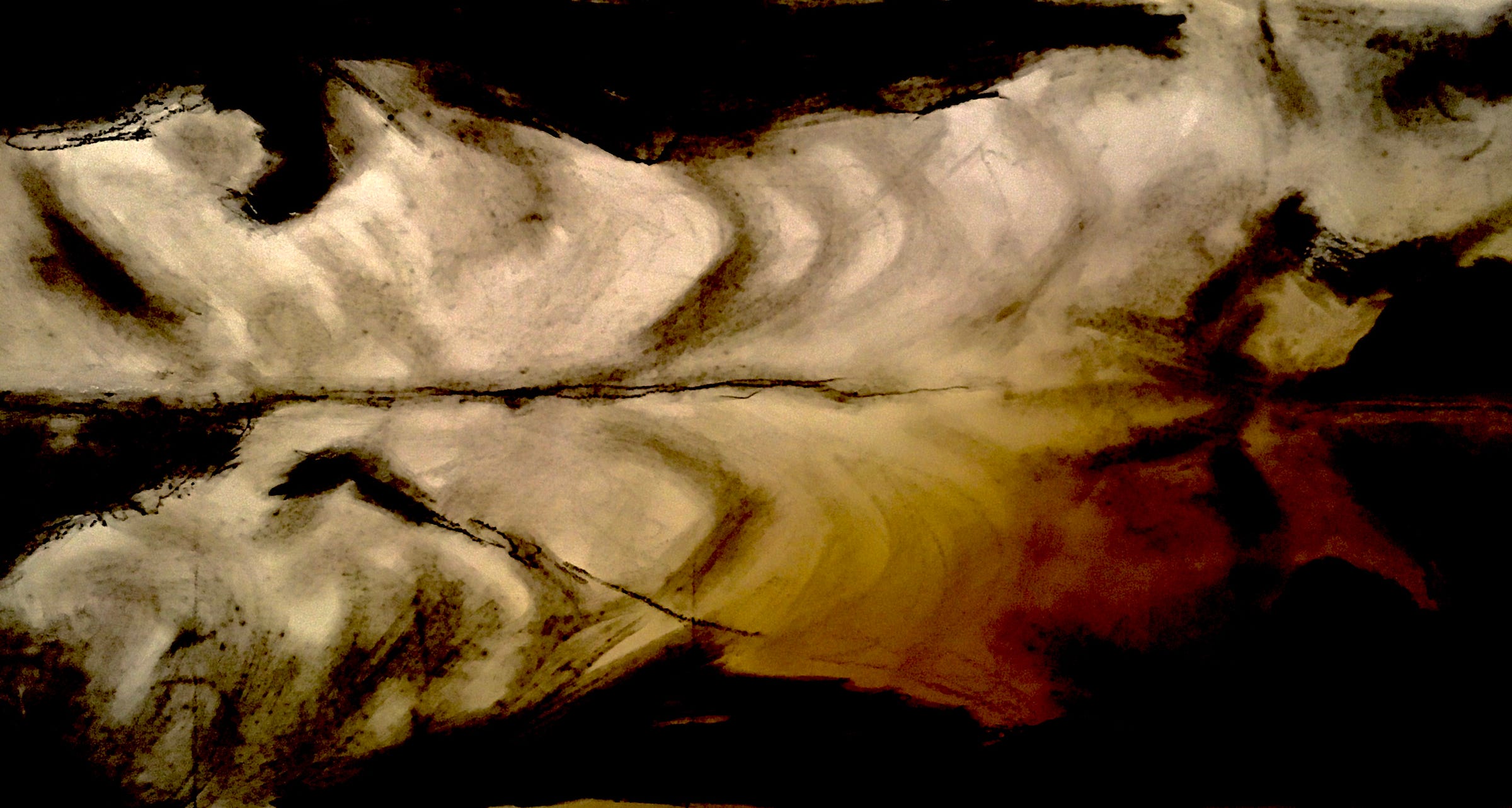The Pinch
The Punch
It’s March, and at least out here in southeastern Washington there are signs of spring. I’m relieved when the air finally starts to get that sweet grassy smell.
It’s been a tough winter for my writing practice between moving, starting a new job, and just reorienting myself in this new (old) life in the rural west. So I’m repeating what I did in March 2024 and sharing some creative writing. Unlike last March’s short story, which had never been published (or, up to that point, finished), the excerpts below were published as part of a larger piece in 2017 for the Scythe Prize and again in 2022 in Emrys Journal.
I wrote Body Snatching while in the thick of my graduate school studies to become a Dance/Movement Therapist. During that time I was completely immersed in exploring the relationship between mind and body—or mental sense of self and physical sense of self, to put it another way—a subject that has obsessed me for most of my life.
The idea that mind and body are wholly separate entities still seems to be an implicit part of Western thought. It does feel sort of intuitive to identify “self” with thoughts and mental activity, which are front and center in our conscious experience. I think we find our bodies mysterious, maybe at times scarily uncontrolled by conscious will. So much is hidden from our awareness and operates from its own intelligence.
I’ve struggled with death anxiety since childhood, so at one point the idea of a self that could be detached from my body’s uncontrolled decay was very comforting. At the same time, my joy and pleasure in living has always revolved around physicality and, well, the experience of being a body on earth. The vignettes below are my 28-year-old self in search of some resolution.
danger
Being a body is dangerous; I don’t recommend it. I realize that if you’re reading this, you are almost definitely a body. But you may also be thinking, “I have a body, but that’s not me. I’m me.” If that’s the case, you’re on the right track and I admire the way you think. I’ll put it this way instead: letting that “Me” feeling settle into your body is dangerous, and should probably be avoided.
By that, I mean feeling your self in your body the way your body might feel in a safe and easy place, like a childhood home. You slouch around with great comfort, noticing as familiar surfaces gather dust. Familiarity, ease, tenderness—danger.
Here’s a question: has a not-too-intimate acquaintance, showing her supreme trust and generosity, ever let you stay in her home for a night or two? Better to feel your body like that—very lightly, cautious, almost wary. Tread softly on the carpet. Don’t open the cupboards.
I only say so because I know how easily a person attaches to those physical joys, and as everyone knows by now, attachment means suffering sooner or later. I’m attached to my body, so attached that I believe Body is all there is and all I want. I know I’d be better off as Essence or Spirit, or whatever you prefer to call formlessness that is safe from rot. The stuff that’s supposed to be everlasting. Make the choice while you still can. Be Spirit. Be comforted knowing that the echo calling “I am me” from its bone cave is what makes you real, not the bones themselves.
Comfort from a stroke on the back is more complicated.
body plans
Body things can obsess a person. Both inside things like feelings, and surface things like colors, textures, the shapes of parts and how gracefully they fit together. I’ve obsessed my way through the insides and outsides of my body. Just when I believe I have obsessed exhaustively, something new comes up to distress or delight me.
In fact, there is obsession now. I fantasize about being mated and impregnated, of my body making a body. I hear this is typical at a certain point in the lifespan, but I feel betrayed by my body for conjuring such a mundane plan for itself.
I tell myself I would like to live out some kind of successful adulthood. I know passing on genes isn’t the only way, but I’m impressed by how hard the body fights for it. It’s the most personal universal way of leaving something of yourself, because it doesn’t get more personal than making a body from your body, yet almost every body on earth feels the same compulsion. I hate doing what everyone else does. I thought I had different plans for myself (I ruled out aging, dying, and procreating), but my body has hijacked those ambitions in the name of the Great Body Plan. All bodies share the same agenda.
I never knew about the agenda until I got a bit older, but I don’t believe this is because the body’s plan kicks in at a certain age. I think that whereas childhood is a time of more body than thought, adults experience more thought than body. A thought-full person is more likely to notice and be disturbed when her body’s plan diverges from her thoughts.
I do miss that body-full time. A time of rituals instead of words.
rituals
A ritual is a body putting itself through the same motions, over and over. But what makes rituals different from routines? Some say the context and purpose: rituals are reverent and conscious; routines are dutiful and thoughtless. Rituals revolve around the invisible, like a person’s soul; routines tend to the tangible, like a person’s teeth.
Either way, everything happens through the body. Isn’t a soul stuck in the same receptacle as the teeth? Whether it’s a ritual or a routine, aren’t the soul, bones and organs all going through the motions together in one container?
I can intellectually see why candle-lighting and prayer get elevated over tooth-brushing, but it feels arbitrary.
invisible things
Some say they see people’s energy, auras, vibrations and other useful personal information. I imagine all of this as a bunch of squiggly lines and rainbows emanating from every body, only visible to the sensitive and gifted. I’m not gifted in that way, although I’d like to be.
The body tells a lot, but evidently not as explicitly as those invisible things. Bodies speak to other bodies, in messages that have no words. Much of the time, I find my thoughts simply don’t know.
not knowing
But then at times the body doesn’t know either, as in learning sequences of movement—a dancer’s choreography. The eyes see actions unfold and disappear. The body repeats what it thinks it has seen, but hasn’t yet felt. The movement is moving—moving from the instructor’s body, which knows and feels it, to a body that doesn’t know. During that time, the movement is body-less, blurry and undefined in the space between.
The body that doesn’t yet hold it moves vaguely, with only the faintest hint of the movement. Repetition changes it each time. It comes slowly into the body with more volume and realization. The movement becomes clearer, boldly outlined, definite, legible. It finally becomes a something that is consciously known to the body and mind.
The mind doesn’t know when it doesn’t know something. In the mind, the something stands fully in light or in darkness. Bodies move through the full spectrum of not knowing.
Thanks for reading, friends. I hope warmth and light come to you quick, wherever you are :)
One last note: The AutoEthnographer republished Topophilia and Inner Landscapes, which I wrote for this newsletter in September 2023. The AE is a very cool online publication highlighting work that is both autobiographical and ethnographic—that explores culture through a personal lens. I’m really pleased to have my work there and highly recommend exploring its many other interesting essays!







I look forward to reading you piece in the AutoEthnographer